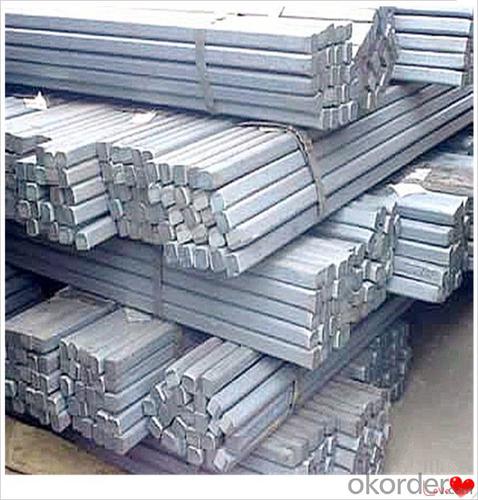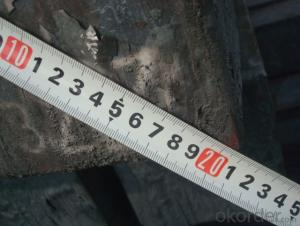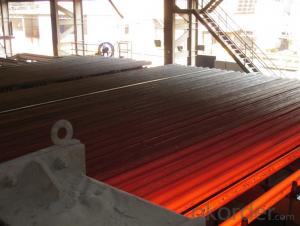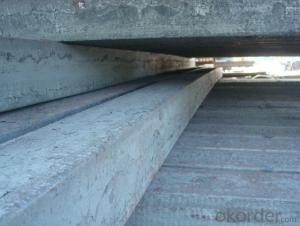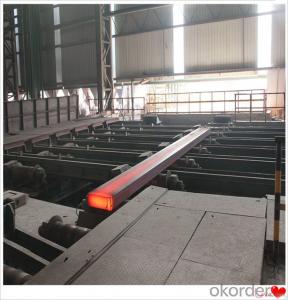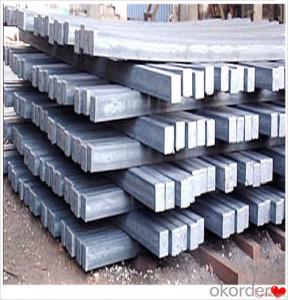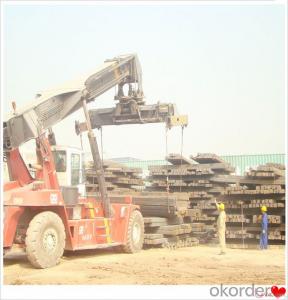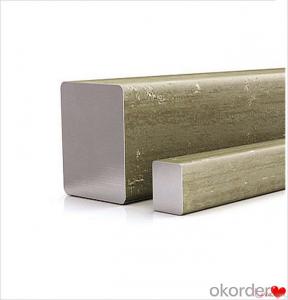Billet Brake Reservoir Q235,Q255,Q275,Q345,3SP,5SP,20MnSi
- Loading Port:
- China main port
- Payment Terms:
- TT OR LC
- Min Order Qty:
- 20 m.t.
- Supply Capability:
- 200000 m.t./month
OKorder Service Pledge
OKorder Financial Service
You Might Also Like
Billet Brake Reservoir Q235,Q255,Q275,Q345,3SP,5SP,20MnSi
Specification
Steel billet(ingot) by cogging or breakdown of semi-finished products, is the raw material of all kinds of steel mill. Billet section of square, round, flat, rectangular and abnormity of several kinds of, mainly related to the shape of rolled products.
CNBM Q235,Q275,Q345,3SP,5SP,20MnSi Billets Steel
Hot Rolled Steel Billets/ Mild Steel Bar/ Billet Steel
Specification (see below)
Standard: GB/JIS/ASTM
Size: 50*50mm-180*180mm
Length: 3-12mtrs or Customised
Steel material: Q235,Q255,Q275,Q345,3SP,5SP,20MnSi
Technique: Hot rolled
FOB Unit Ton Price $250-350 and Usually I will quote you CFR price.
MOQ: Usually 1000-10000MT/size
Shipment:By Container,Bulk Vessel
Packaging Details: bundles with steel strips or as customers's requirements
Delivery time: Usually within 30 days after the deposit/LC
Inspection:Third party inspection before loading.
Technical data
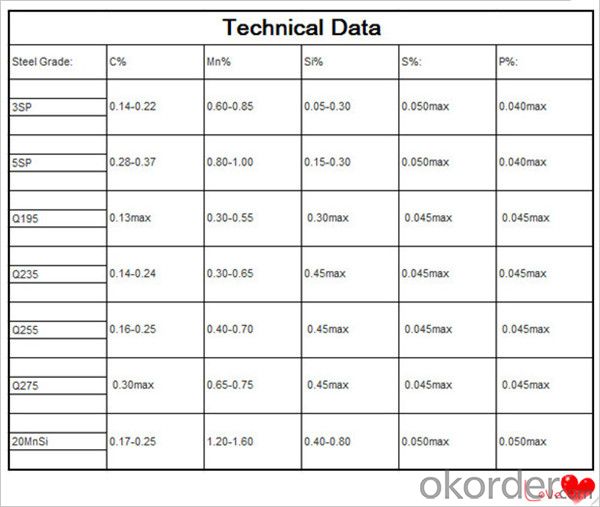
Feature Steel Billet
Rectangular billet continuous casting billet and mainly general carbon steel, low carbon low silicon cold-rolled material, high quality carbon structural steel, high strength low alloy steel, special steel, etc.
The billet is mainly divided into two kinds from the shape:
Slab: cross section width and height of the ratio of the larger, mainly used for rolling plate.
Billet: equal cross section width and height, or a huge difference, mainly used for rolling steel, wire rod. ,
Steel billets have distinct characteristics as compared with already furnished steel bars and products. Billets have a specific grain structure, which enables the metal to be processed more intricately. Steel billets are also known for their malleability and ductility, especially when exposed to varying temperatures during shaping and molding.
Packaging & Shipping
1. Packaging:
1) Small size: in bundles
2)Big size: in bulk
3)in plastic packing or as per customer requirement
2. Delivery time:
1) Normal size: within 7days send from warehouse directly
2) Special size: with 25-30days customer made for you
3. Trade terms:FOB/CFR/CIF
4. Shippment:
1) length:≤5.8m loaded in 20FT Container with 25-27tons
2) length:≤11.8m loaded in 40FT Container with 25-27tons
3) lengnth:≥12m shipped by bulk vessel, FILO terms
Steel Billet Images
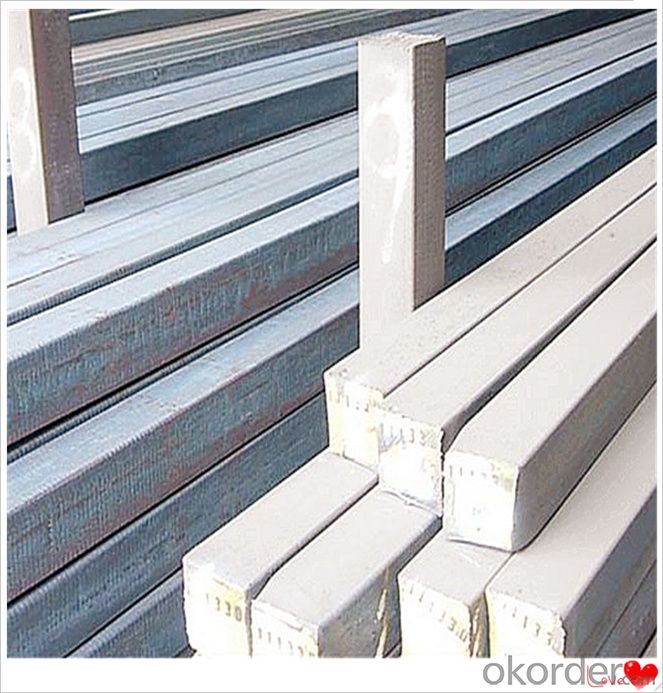
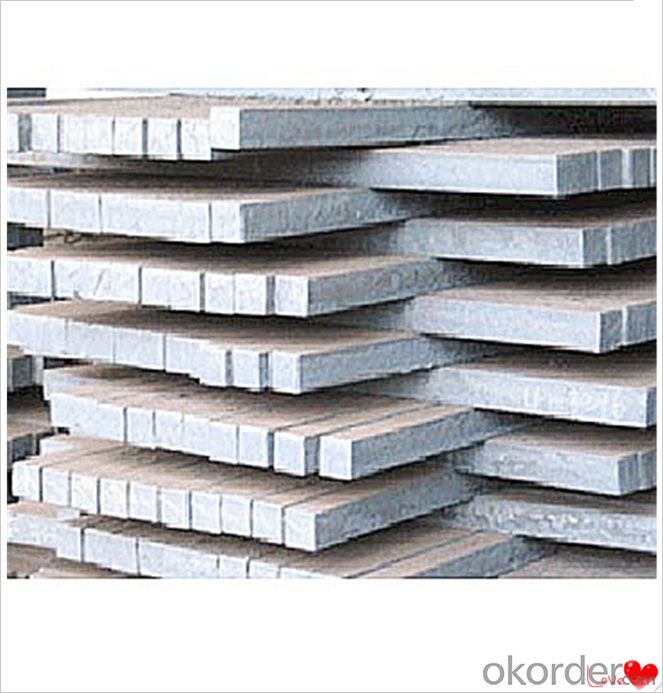
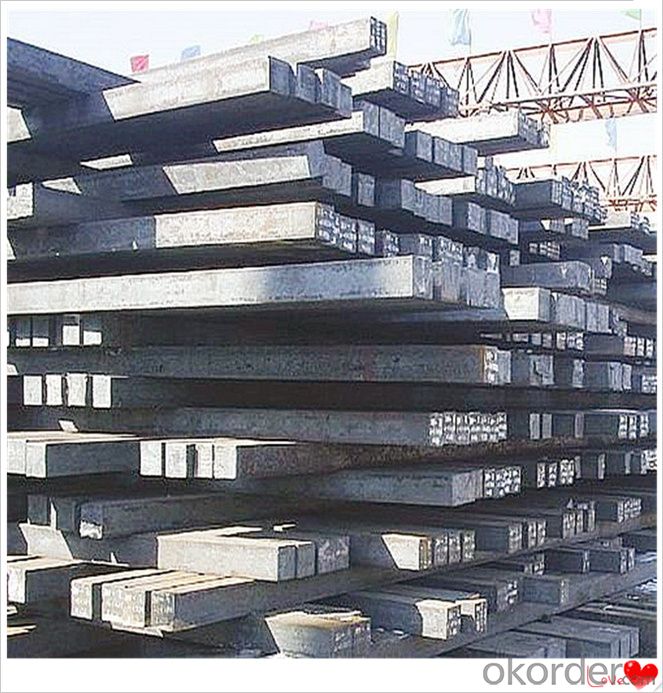

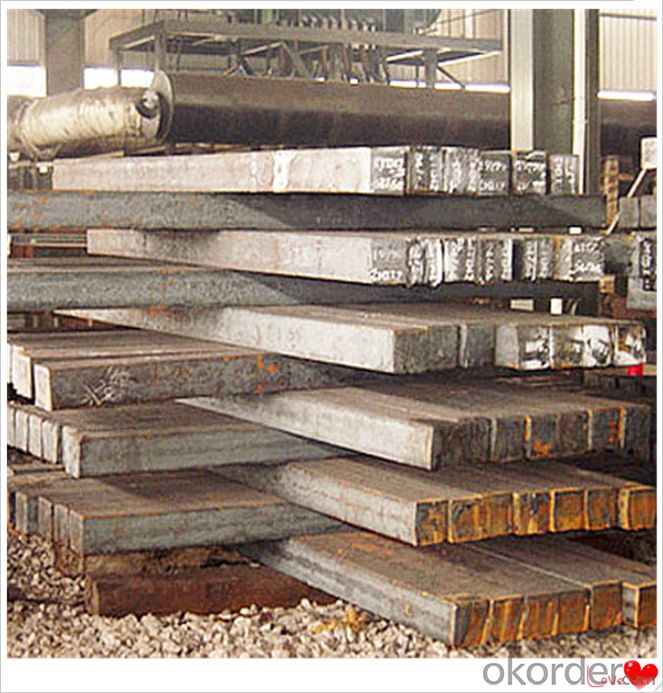
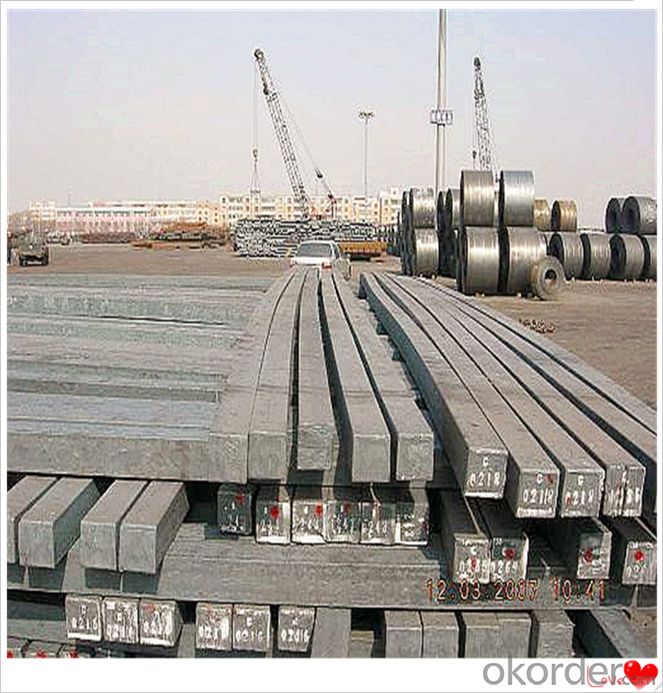
Processing
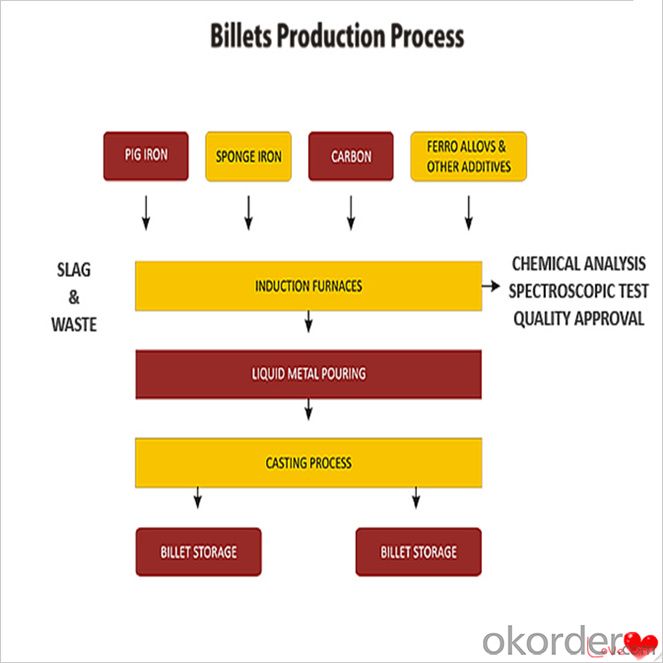
Usage-Billet Steel
Used for the plant, the bridge,shipment building high-rise building construction,lifting and transportation machinery, equipment manufracturing base building the support foundation pile manufacturing.
Billets, or ingots (as they sometimes referred to), are not of practical use until they have been formed into more functional shapes and sizes. While they have already been put in the furnace, they still require a series of shaping and molding procedures such as hot and cold working, milling and cutting before they are sold in hardware stores, or used for different applications. The unformed billets, however, can be used in striking currency such as coins and as reserves, similar to gold bars.
FAQ-Billet Steel
We have organized several common questions for our clients,may help you sincerely:
1) How about your company?
A world class manufacturer & supplier of castings forging in carbon steel and alloy steel,is one of the large-scale professional investment casting production bases in China,consisting of both casting foundry forging and machining factory. Annually more than 8000 tons Precision casting and forging parts are exported to markets in Europe,America and Japan. OEM casting and forging service available according to customer’s requirements.
2) How to guarantee the quality of the products?
We have established the international advanced quality management system,every link from raw material to final product we have strict quality test;We resolutely put an end to unqualified products flowing into the market. At the same time, we will provide necessary follow-up service assurance.
3) How long can we receive the product after purchase?
In the purchase of product within three working days, We will arrange the factory delivery as soon as possible. The pecific time of receiving is related to the state and position of customers.Commonly 7 to 10 working days can be served.
4)Do you have your own QC department?
Yes, we have, our QC department will inspect the goods during the process of mass production and after completion of production.
hot sale!!! Cast Steel Grades/ mild steel bar/ billet steel
(1): High quality steel with reasonable price.
(2): Wide excellent experiences with after-sale service.
(3): Every process will be checked by responsible QC which insures every product's quality.
(4): Professional packing teams which keep every packing safely.
(5): Trial order can be done in one week.
(6): Samples can be provided as your requirements.
- Q: What are the main factors that determine the demand for steel billets in different industries?
- The main factors that determine the demand for steel billets in different industries are the overall economic conditions, including GDP growth and industrial production, as well as the specific needs and requirements of each industry. Other factors include the level of infrastructure development, population growth, urbanization, and construction activities. Additionally, factors such as technological advancements, environmental regulations, and government policies can also influence the demand for steel billets in different industries.
- Q: Are steel billets used in the production of household goods?
- No, steel billets are typically not used in the production of household goods. They are usually used as raw materials in steel mills for the production of various steel products, such as bars, rods, pipes, and structural components.
- Q: How are steel billets used in the production of structural sections?
- Steel billets are an essential raw material in the production of structural sections. These sections, such as beams, columns, and girders, are crucial components in the construction industry and are used to create sturdy and durable buildings, bridges, and other infrastructure. To begin the production process, steel billets are heated to extremely high temperatures in a furnace. This process, known as "hot rolling," makes the steel more malleable and easier to shape. Once the billets have reached the required temperature, they are passed through a series of rollers to gradually reduce their thickness and shape them into the desired structural section. The hot rolling process ensures that the steel maintains its strength and structural integrity while being shaped. It also helps to align the grain structure of the steel, resulting in improved strength and ductility. Moreover, the hot rolling process eliminates any internal stresses within the steel, making it less prone to cracking or failure. After the hot rolling process, the structural sections are cooled down and then cut to the desired length. They may also undergo additional treatments, such as straightening or surface finishing, to meet specific requirements or improve their aesthetics. Overall, steel billets play a crucial role in the production of structural sections. By providing the raw material that is shaped and processed, steel billets ensure that the resulting sections possess the necessary strength, durability, and stability required for construction projects.
- Q: How do steel billets contribute to the strength of a structure?
- There are multiple ways in which steel billets contribute to the strength of a structure. To begin with, steel billets are created through the casting process, where molten steel is poured into molds and allowed to solidify. This casting method ensures that the steel billets have a consistent and uniform composition, with minimal impurities. As a result, the final product's structural integrity and strength are enhanced. In addition, steel billets undergo hot rolling or cold rolling, which further enhances their strength. Hot rolling involves heating the steel billets to high temperatures and passing them through a series of rollers to compress and shape the steel into the desired form. This process aligns the steel's grain structure, making it stronger and more resistant to deformation. Furthermore, steel billets are commonly used as raw material for manufacturing other steel products like beams, columns, and plates. These fabricated steel components are then incorporated into structures, providing additional strength and support. The high strength and durability of steel billets make them ideal for withstanding heavy loads, seismic forces, and other external pressures. In addition, steel billets can be alloyed with other elements like carbon, manganese, and chromium to enhance their mechanical properties and increase their strength. The inclusion of these alloying elements improves the steel's hardness, toughness, and resistance to corrosion, making it even more suitable for structural applications. Overall, the role of steel billets in enhancing the strength of a structure is crucial. Through their uniform composition, hot or cold rolling processes, and alloying capabilities, steel billets contribute to the overall structural integrity, durability, and load-bearing capacity of buildings, bridges, and other infrastructure projects.
- Q: Billet heating furnace prices?
- The reheating furnace control mode according to the different tonnage, heating medium, price range, or recommendations according to your requirements, find good few industry units do offer the program, compared to eradicate the solution and quotation.
- Q: What are the main factors affecting the toughness of steel billets?
- The main factors affecting the toughness of steel billets include the chemical composition of the steel, the heat treatment process, the presence of impurities or defects, and the grain size and structure of the steel.
- Q: What are the different types of steel billet inspection equipment?
- There are several different types of steel billet inspection equipment used in the manufacturing industry. These equipment are specifically designed to ensure the quality and integrity of the steel billets before they are further processed. 1. Ultrasonic Testing (UT) Equipment: This type of equipment uses high-frequency sound waves to detect internal flaws or defects in the steel billets. It can identify cracks, voids, and other imperfections that may affect the strength and performance of the final product. 2. Magnetic Particle Inspection (MPI) Equipment: MPI equipment uses a magnetic field and specially formulated particles to identify surface and near-surface defects in the steel billets. It can detect cracks, seams, and other imperfections that may not be visible to the naked eye. 3. Eddy Current Testing (ECT) Equipment: ECT equipment uses electromagnetic induction to detect surface cracks and defects in the steel billets. It can identify variations in electrical conductivity caused by localized defects or changes in material properties. 4. Visual Inspection Equipment: Visual inspection equipment includes tools such as magnifying glasses, microscopes, and cameras to visually examine the steel billets for surface defects, irregularities, or other visual anomalies. This type of equipment is often used in conjunction with other inspection methods for a comprehensive analysis. 5. Dimensional Measurement Equipment: This type of equipment is used to measure the dimensional accuracy and consistency of the steel billets. It includes tools such as calipers, micrometers, and laser scanners to ensure that the billets meet the required specifications and tolerances. 6. Surface Roughness Measurement Equipment: Surface roughness measurement equipment is used to quantify the surface finish of the steel billets. It uses a stylus or laser to measure the irregularities on the surface, providing important information about the billet's suitability for further processing. 7. X-ray Testing Equipment: X-ray equipment uses electromagnetic radiation to penetrate the steel billets and detect internal defects such as cracks, voids, or inclusions. This method is particularly effective for larger billets or when a comprehensive assessment of the internal structure is required. These are some of the commonly used steel billet inspection equipment in the manufacturing industry. Each type of equipment plays a crucial role in ensuring that the steel billets meet the required quality standards and are suitable for further processing into various end products.
- Q: How do steel billets contribute to energy efficiency?
- Steel billets have a significant impact on energy efficiency in various ways: 1. Enhanced production efficiency: Steel billets serve as the initial form of steel utilized in different manufacturing processes. Employing steel billets as the starting material allows manufacturers to achieve higher production efficiency. The uniform size and shape of billets facilitate easier handling, cutting, and shaping, thereby reducing energy consumption during manufacturing. 2. Optimized resource utilization: Steel billets are commonly produced from recycled steel scrap. By employing recycled steel as the raw material, manufacturers minimize the need for extracting and processing virgin iron ore, a highly energy-intensive procedure. This conservation of natural resources helps in reducing overall energy consumption related to steel production. 3. Efficient heat recovery: The manufacturing of steel billets necessitates high temperatures for melting and shaping the steel. However, modern steel plants are equipped with advanced technologies that enable efficient heat recovery. The excess heat generated during the process can be captured and utilized for various purposes, such as generating steam or heating other areas of the plant. This heat recovery system effectively reduces energy wastage and enhances overall energy efficiency. 4. Employment of energy-efficient equipment: Steel billet production often involves the use of heavy machinery and equipment. Manufacturers are increasingly investing in energy-efficient technologies and equipment to minimize energy consumption. For instance, the utilization of more efficient electric arc furnaces or induction heating systems can significantly reduce energy requirements compared to traditional methods. These technological advancements contribute to the overall energy efficiency of steel billet production. In conclusion, steel billets play a pivotal role in enhancing energy efficiency in the steel industry. Their impact is evident in production efficiency, resource optimization, heat recovery, and the utilization of energy-efficient equipment. By minimizing energy consumption, the use of steel billets promotes a more sustainable steel manufacturing process.
- Q: Fish pole carbon cloth tcf. Vcf. Svf. Hcf. On behalf of what?
- CF: is the abbreviation of Carbon Fiber in English, which means carbon fiber in ChineseCarbon fiber index for T (ton), ordinary carbon cloth is generally 20T-30T.Domestic ordinary carbon fishing rod material is generally 24T carbon fiber cloth. The higher the T value, the higher the strength and elasticity of the material.
- Q: Are steel billets subject to any regulations or certifications?
- Steel billets must adhere to numerous regulations and certifications to guarantee their production, quality, and safety standards are met. The ISO 9001 certification, an internationally recognized standard for quality management systems, is one of the most common certifications for steel billets. This certification ensures that the manufacturing process of steel billets follows consistent quality control measures, from sourcing raw materials to final production. Steel billets may also need to obtain industry-specific certifications, depending on their intended use. For example, if the steel billets are intended for construction projects, they must comply with certifications such as ASTM standards or European EN standards. These certifications define the necessary mechanical properties, chemical composition, and other specifications that steel billets must meet to ensure they are suitable for construction purposes. In addition, governmental bodies or industry associations may impose regulations on steel billets. These regulations can include safety standards, environmental regulations, and compliance with trade policies. For instance, steel billet producers may need to comply with regulations regarding emissions, waste management, or occupational health and safety. In conclusion, various regulations and certifications are in place to ensure the quality, safety, and compliance with industry standards of steel billets. These certifications and regulations are crucial for maintaining the integrity of steel billets and ensuring they are suitable for various applications.
Send your message to us
Billet Brake Reservoir Q235,Q255,Q275,Q345,3SP,5SP,20MnSi
- Loading Port:
- China main port
- Payment Terms:
- TT OR LC
- Min Order Qty:
- 20 m.t.
- Supply Capability:
- 200000 m.t./month
OKorder Service Pledge
OKorder Financial Service
Similar products
Hot products
Hot Searches
Related keywords






